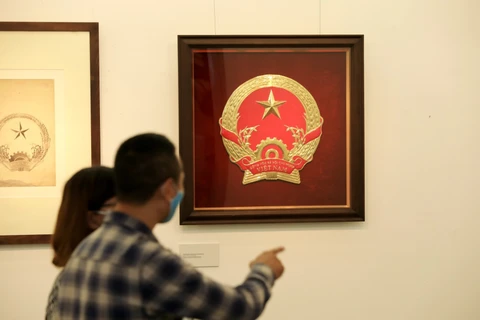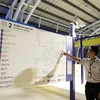Hanoi (VNS/VNA) - A special exhibition has just wrapped up at the Vietnam National Fine Arts Museum that delved into the creative process of designing the National Emblem.
In 1951, the Ministry of Foreign Affairs of the Democratic Republic of Vietnam identified the need to assert national sovereignty and to assist the development of international relations with the National Assembly.
Soon after, the ministry launched an emblem design contest for the then Democratic Republic of Vietnam. Many entries were received but no finalists were selected. Later, painter Bui Trang Chuoc was recommended and selected to be the final designer.
Having graduated from L'Ecole des Beaux Arts de L'Indochine (Indochina Fine Arts School), Chuoc had taught graphic design in Da Lat before the August 1945 Revolution.
He was a master graphic designer, experienced in creating important designs for bank notes, postage stamps and merit medals. Some of his sketches on tracing paper show the painstaking process it took to achieve perfect symmetry without support of computer algorithms.
During his brainstorming process, 94 drafts were narrowed down to 15 options with careful explanatory notes. Inspired by other socialist countries’ national emblems, he put careful thought into what would best represent the nation.
To symbolise the country’s progress and transition between agricultural and industrial practices, symbols like the rubber plantations, factories, an anvil and a cog wheel all featured his drafts to represent economic diversity.
At first, Chuoc wanted to include bamboo trees and the buffalo, two agricultural icons, but after due consideration he realised they were shared symbols with other Asian countries, so he decided to use historic locations such as the Hung Temple, the Dong Da Mound and Quan Chuong Gate in Hanoi instead.
However, he was still not satisfied, believing they didn’t portray enough meaning. Eventually he settled on the flag as its simple design could represent both the nation and its people.
After receiving feedback from President Ho Chi Minh and the National Assembly, the final version was chosen in 1956, in which ripe rice bundles represented agricultural strength on both sides of the circle, hugging the symbol of industrialisation, the cog wheel in the middle. The soft red silk ribbons with the “Democratic Republic of Vietnam” letters enclosed both symbols. Inside the circle, the national flag filled the space with a bright yellow star high on top, which was believed to help guide the way for the nation’s future development and progress.
Unfortunately, the final design, edited by painter Tran Van Can due to time constraints, gained him the credit instead.
Although Chuoc was upset, he did not make a big scene about it. Decades later, in 1973, he wrote a letter to the then Prime Minister Pham Van Dong to ask for clarification but did not receive a reply. In 1985, he wrote a three page essay titled “I Draw the National Emblem” explaining his journey designing the emblem, and gave it to his family.
Artists Vu Giang Huong, Tran Khanh Chuong and Trieu Duong disputed his claims, giving credit to painter Can.
However, no clarification is now available as they have all since passed away. While there was no deliberate attempt to steal the credit from Can, the matter divided experts.
Some officials even suggested the credit should be shared between both artists. Ultimately, a careful investigation proved painter Chuoc case and recognised his dedication and effort to design the National Emblem.
While the identity of the creator remained unknown to the public for a long time, at last he has finally been recognised through this exhibition and will be under consideration for Ho Chi Minh Award for Literature and Arts in the near future.
Additionally, the State Records and Archives Management Department of Vietnam plans to make a dossier to submit to the Government for consideration of the National Emblem as a national treasure./.
VNA





















